Patricia Tobacco Forrester was born in 1940 in North Hampton, Massachusetts, and she died in 2011 in Washington, DC. When her grandfather, bearing the last name Tobczynski, arrived at Ellis Island, the authorities changed it to Tobacco. The family had a small farm where they raised asparagus, cucumbers, and tobacco. Patricia’s interest in art began early in life. She graduated (Phi Beta Kappa) in 1962 from Smith College in Massachusetts. She earned a bachelor’s degree in printmaking and sculpture. A teacher and major influence was Leonard Baskin (1922-2000), a well-known American sculptor and printmaker. She went on to earn a BFA (1963) and an MFA (1965) from Yale University. She married and divorced Alex Forrester in the 1960s.
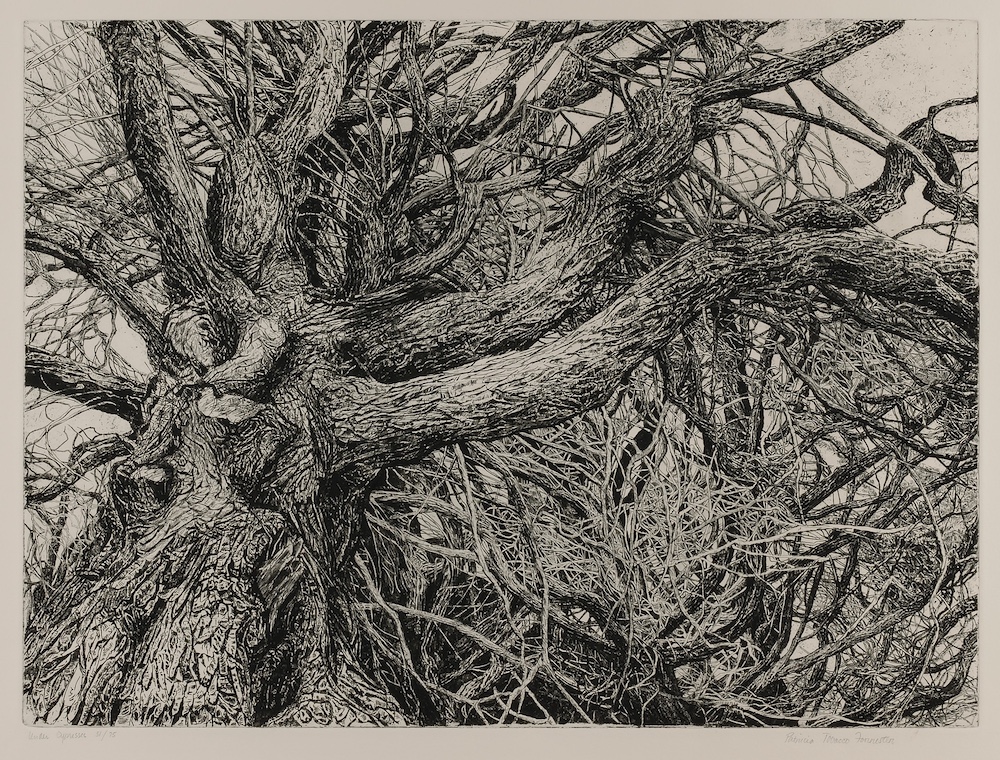
“Under Cypresses” (1967)
Forrester received a Guggenheim Fellowship in 1967 and produced a series of etchings. “Under Cypresses” (1967) (18”x24”) (etching) is in the collection of the Smithsonian Museum of American Art in Washington, DC. Beginning with her earliest works, she exhibited an interest in nature observed up-close and in minute detail. She was fascinated by the massive cypress trunk with its twisting branches, rough bark patterns, and the sea grasses growing around it. Her work would continue to show the amazing twists, turns, and textures of nature.
She met and married Paul Ekman in San Francisco. Ekman became an international expert on body language, human emotions, and psychology. They traveled to Southeast Asia and the Pacific Islands. He studied the people, and she studied and painted the landscape. She continued to live in San Francisco after her divorce from Ekman in the late 1970s. In addition to making art, she served from 1972 until 1981 on the faculty of the Californian College of Arts and Crafts in Oakland. She then moved east, teaching at Kent State University in Ohio (1981) and the Art Institute of Chicago (1982). She resided in Washington, DC, in 1982 until her death in 2011.
Most of Forrester’s work covered in this article can be found in local museums and collections.

“Monjas Blancas at the Volcana’’ (1988)
Forrester’s travels to exotic locations continued throughout her life. Her chosen medium was watercolor. Watercolor paintings in general tended to be small in scale. However, Forrester chose the unexpected size of 40” by 60” for her watercolors. They were a great success, bringing her recognition, exhibitions, commissions, and sales.
Her love of nature determined her subject matter, and her love of watercolor determined her media. “Monjas Blancas at the Volcana’’ (White Nuns at the Volcano) (1988) (40”x60”) (watercolor) was painted in Guatemala. Seated on the ground, with her large 40”x60” watercolor paper, she painted en plein air, a tremendously difficult feat that produced remarkable paintings.

“Avila, Caracas” (1990)
“Avila, Caracas” (1990) (40”x60”) (watercolor) (Easton Museum of Art, Easton MD) was painted in Caracas, the capital of Venezuela, set in the Andes mountains. At El Avila National Park the mountains rise 9072 feet above the City. With her usual attention to minute detail, Forrester painted a variety of flowering plants, grasses, trees, and shrubs, with rocky cliffs in the distance. Avila Park is a popular hiking destination.
Forrester was elected in 1992 to the National Academy of Design in New York City as an associate member, and in 1994 she became a full Academician. The National Academy of Design is the premier professional honorary organization for American artists and architects. Academy members nominate and elect their peers, and the number of members is limited to just 450. Artists cannot apply for membership.
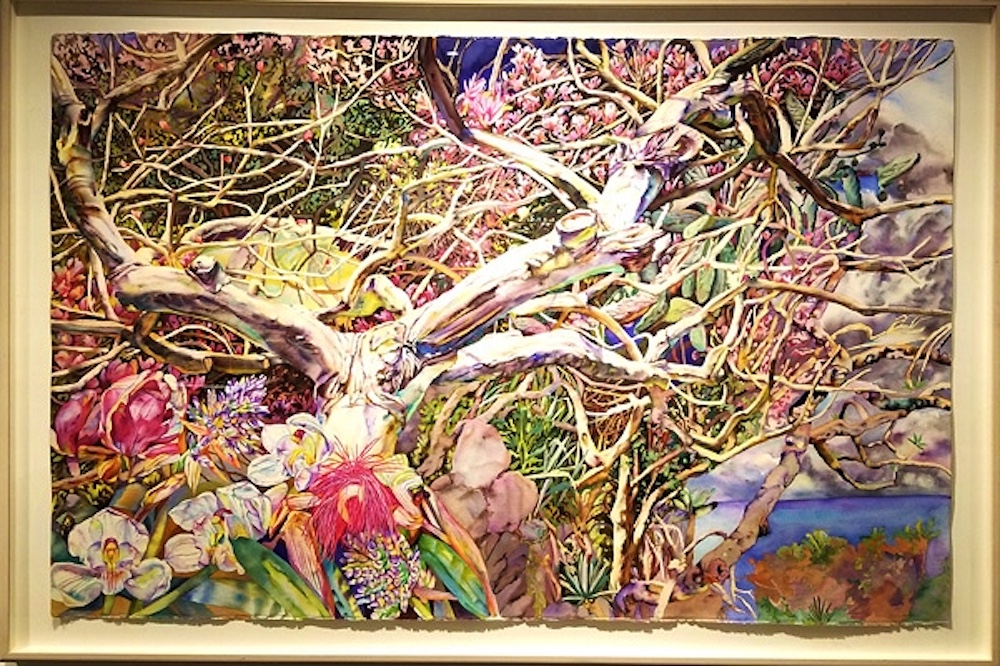
“Barbados” (1995)
“Barbados” (1995) (40”x60”) (watercolor) (National Museum of Women in the Arts, Washington, DC) is an example of why Forrester frequently called her work abstract because of the “accidental nature of watercolor.” Her images are not pre-planned but evolve as she paints. Barbados, one of the many island nations off the north coast of South America, has a rich environment of tropical plants. A little bit of the sky and the blue waters of the Atlantic are included in the composition. The on-line images of the paintings by Forrester do not capture the complexity and uniqueness of her work. The following two details may help.

“Barbados” (detail lower left corner)
Forrester uses two different watercolor techniques. Dry watercolor applies paint to the dry surface of the paper, which results in crisper edges of images. Most notable here are the dark background areas on which the flowers are painted. The wet-on-wet technique requires the paper to be wet when the paint is applied. This is where surprises can occur, as the watercolor paint spreads uncontrolled across the wet surface. The effect can be seen in the soft edges of the paint on the large red blossom. Forrester appreciated the surprise effect, and she embraced the technique in her paintings.
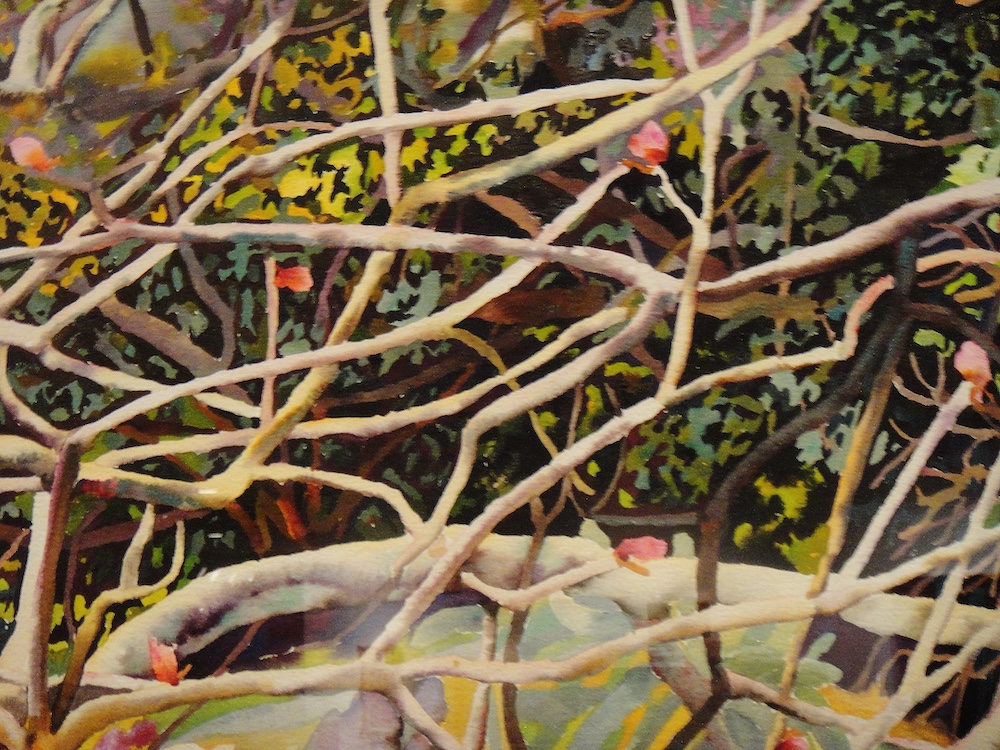
“Barbados” (detail middle left)
In this detail, the light branches form an interesting crisscross composition, while patterns representing leaves and flowers dance in front of the dark background. The whole composition of the painting works, but often another composition is contained in a single detail of a Forrester painting.
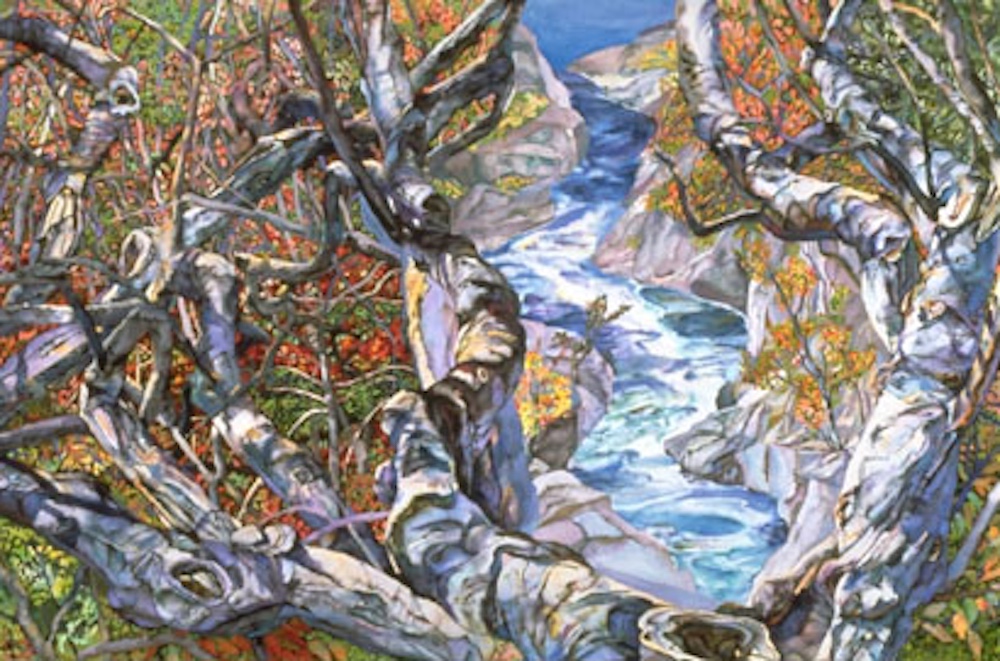
“Great Blue Divide”
A prolific painter and sometime printmaker, Forrester did not lack subject matter or commissions during the 29 years she resided in Washington, DC. She found inspiration in the many parks, the National Arboretum, and other beautiful places nearby in Maryland and Virginia. “Great Blue Divide” (40”x60”) (date unknown) was painted at Great Falls National Park, along the Potomac River in Fairfax County, Virginia.
Forrester traveled from Washing back to San Francisco and the Islands, particularly during the winter months. Her favorite destination was Costa Rica, where health issues developed that eventually led to her death.
Forrester’s work can be found in Hillwood Estates Museum and Gardens, the White House, the Executive Office Building, the Washington Convention Center, the US Department of State, and private residences. She donated a large collection of her work to the Smithsonian Museum of American Art. Her work also is included in the collections of The Brooklyn Museum in New York City, the Art Institute of Chicago, and the British Museum in London, among others.
Forrester once remarked about the National Arboretum, “I think I know almost every tree and flower there.”
Beverly Hall Smith was a professor of art history for 40 years. Since retiring to Chestertown with her husband Kurt in 2014, she has taught art history classes at WC-ALL and the Institute of Adult Learning, Centreville. An artist, she sometimes exhibits work at River Arts. She also paints sets for the Garfield Theater in Chestertown.
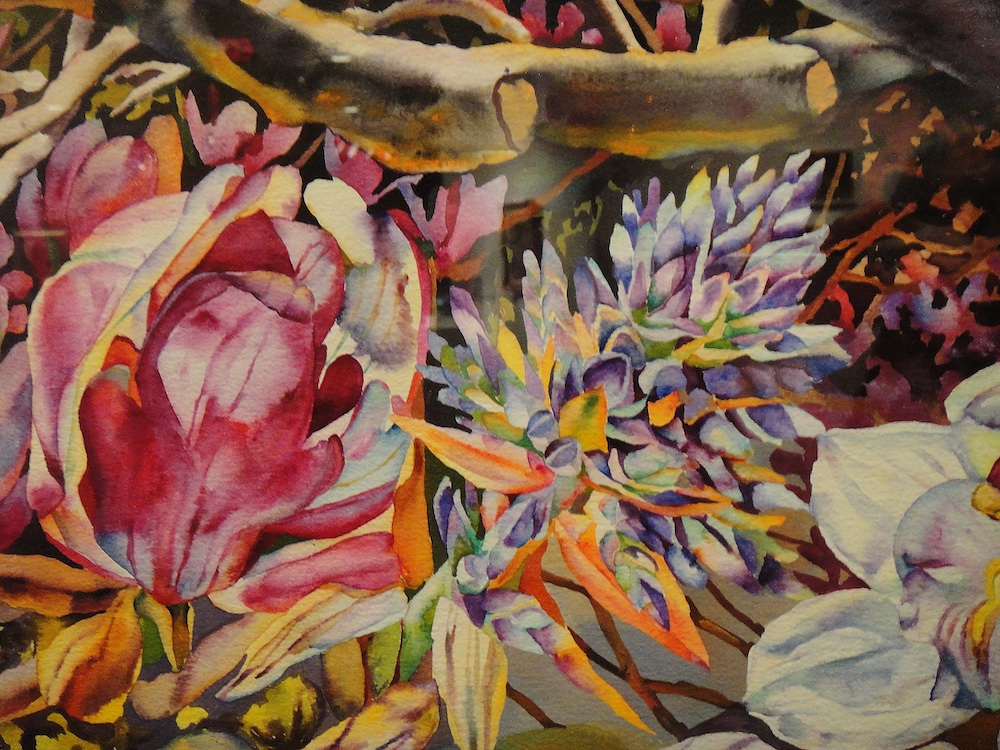


Write a Letter to the Editor on this Article
We encourage readers to offer their point of view on this article by submitting the following form. Editing is sometimes necessary and is done at the discretion of the editorial staff.